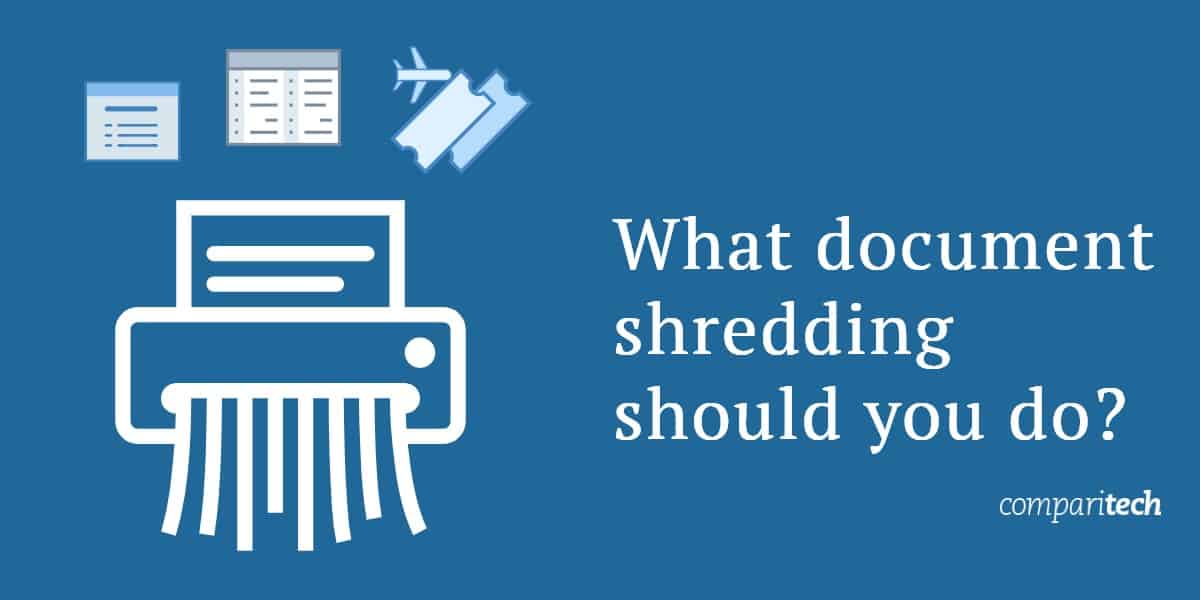
To Shred or Not to Shred. That is the Question.
Can someone legally dig through your trash looking for tasty credit card receipts, account numbers, or your social security number (SSN)? The U.S. Supreme Court implies that the answer is yes. In the decision California vs. Greenwood, they stated that the “expectation of privacy in trash left for collection in an area accessible to the public… is unreasonable.”
In other words, when you throw something in the trash, it is available to anyone willing to overlook the disgusting smells and textures of your trash can or dumpster.
What document shredding should you do?
The easy answer – anything that has a signature, account number, social security number, or medical or legal information (plus credit offers).
The complete answer – see below.
- Address labels from junk mail and magazines
- ATM receipts
- Bank statements
- Birth certificate copies
- Canceled and voided checks
- Credit and charge card bills, carbon copies, summaries and receipts
- Credit reports and histories
- Documents containing the maiden name (used by credit card companies for security reasons)
- Documents containing names, addresses, phone numbers or e-mail addresses
- Documents relating to investments
- Documents containing passwords or PIN numbers
- Driver’s licenses or items with a driver’s license number
- Employee pay stubs
- Employment records
- Expired passports and visas
- Unlaminated identification cards (college IDs, state IDs, employee ID badges, military IDs)
- Legal documents
- Investment, stock and property transactions
- Items with a signature (leases, contracts, letters)
- Luggage tags
- Medical and dental records
- Papers with a Social Security number
- Pre-approved credit card applications
- Receipts with checking account numbers
- Report cards
- Resumés or curriculum vitae
- Tax forms
- Transcripts
- Travel itineraries
- Used airline tickets
- Utility bills (telephone, gas, electric, water, cable TV, Internet)
How do I shred documents?
There are a few ways you can go about shredding documents.
1. Use a document shredding service
The first, and perhaps easiest, is simply locate a company that will do documenting shredding for you.
In the US, OfficeMax, Office Depot, and Staples all perform paper shredding services. The cost is usually $1 per pound, which is fairly cheap when you consider how lightweight documents tend to be. Occasionally, you can find coupons that will let you do document shredding at these companies for free.
If you can’t find an OfficeMax, Office Depot, or Staples near you, parcel and mail companies often perform these services as well. FedEx, for example, offers document shredding services for $1.49 per pound. UPS also has a shredding service available, although prices are not listed on its company website.
You may also find locally-owned and independent companies that handle paper shredding for a small fee.
Related: identity theft protection
2. Purchase a document shredder
If you plan to do a lot of document shredding yourself, you may want to invest in a simple paper shredder for your home. They can be purchased for a low cost (under $30 for some), but some cost over $200 dollars. The more expensive the document shredder, the faster it shreds and the more documents it can handle at a time. Some also come with features that let you shred special types of documents, or can shred documents that are stapled.
3. Use the pulping method
If you want to have a little fun with your documents, you can use the pulping method. This method involves pouring bleach and water over your documents in a large trash can or container, allowing the chemicals to break down the paper, and then mashing them together into a paste. This method guarantees that nobody can reconstruct your sensitive documents, and you can still dump the resulting mixture in the trash.
Of course, you can always be environmentally friendly and turn those old papers into fuel to heat your home.
4. Burn instead of using document shredding
This is a method we do not recommend. Trash burning is an option, but you will need to check your local laws. Do NOT burn paper in an indoor fireplace, stove, or wood oven. Documents often contain chemicals that can send off toxic fumes.
Does document shredding really work?
Document shredding is a perfectly safe and easy way to ensure your sensitive documents cannot be used for identity theft. However, you will want to make sure you are shredding your documents properly. Improperly shredded documents are easy to piece back together. Instead of using scissors to cut your documents, for example, use the methods we mentioned above to ensure that your information is secure.
Identity theft is usually a crime of convenience; thieves will avoid any theft that requires a lot of effort. Properly shredded documents are difficult to put back together and will be an unlikely target for identity thieves.
